10 Data Analytics Books for Beginners: The Best Guide
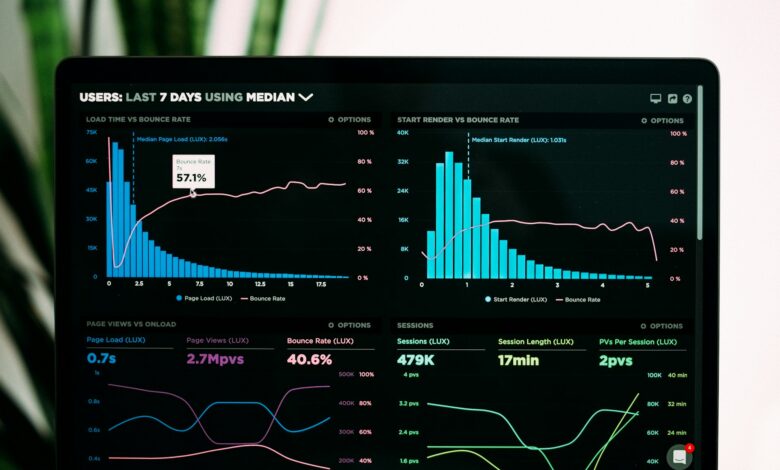
Discover the gateway to expertise in data analytics books—a realm where knowledge transforms into actionable insights. In a world driven by data, understanding the nuances of statistical modeling, machine learning algorithms, and predictive analytics is paramount. This guide navigates through a curated selection of authoritative resources, designed to unravel complexities and empower both novice learners and seasoned professionals alike. Whether you’re venturing into dataIntroduction science or refining your analytical skills, delve into this comprehensive exploration of books that promise to illuminate, educate, and elevate your understanding of data analytics. Embark on a journey of discovery and mastery, where each page offers a new perspective on harnessing the power of data for informed decision-making.
Table of Contents
What is Data Analytics?
Data analytics is the systematic process of examining large datasets to uncover hidden patterns, correlations, and insights. It involves applying statistical algorithms and machine learning techniques to raw data, transforming it into actionable information for decision-making. Through data preprocessing and exploratory data analysis (EDA), analysts delve deep into data to understand trends and relationships. In the realm of data analytics books, these resources serve as foundational guides, offering expertise in predictive modeling, data visualization, and business intelligence. Understanding data analytics is crucial in today’s digital age, where organizations harness data to optimize strategies and gain competitive advantages.
Books about Data Analytics for Beginners
1. Data Analytics Made Accessible by Dr. Anil Maheshwari
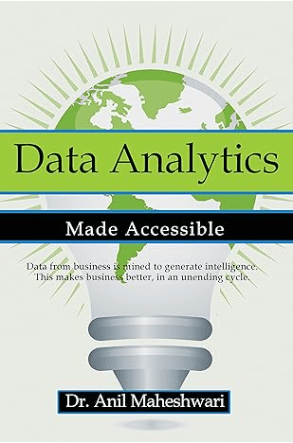
Data Analytics Made Accessible by Dr. Anil Maheshwari presents a captivating journey into the realm of data analytics. Dr. Maheshwari’s book masterfully demystifies complex data analytics concepts, making them comprehensible for both novices and seasoned professionals. Through clear explanations and real-world examples, the book delves into essential data mining techniques and statistical analysis methods. It emphasizes practical applications across diverse sectors, illuminating how businesses can harness data to drive strategic decisions and innovations. Maheshwari’s accessible approach fosters a deep understanding of big data principles and machine learning advancements, positioning readers to navigate and leverage the transformative potential of data analytics effectively.
- Introduction to Data Analytics: Maheshwari introduces readers to the fundamental principles of data analytics, emphasizing its importance in today’s data-driven world.
- Statistical Foundations: The book covers essential statistical techniques used in data analysis, such as descriptive statistics and inferential statistics, providing a solid grounding for understanding data patterns.
- Practical Applications: Maheshwari explores practical applications of data analytics across various industries, showcasing how organizations can harness data to drive strategic decisions.
- Data Mining and Predictive Modeling: Readers delve into data mining techniques and predictive modeling, learning how to uncover hidden patterns and make forecasts based on historical data.
- Data Visualization: The book emphasizes the importance of data visualization in conveying insights effectively, with examples of tools and techniques for presenting data visually.
- Interpreting Results: Maheshwari guides readers through the process of interpreting analytical results, focusing on extracting actionable insights from complex datasets.
- Real-World Examples: Throughout the book, Maheshwari uses real-world examples to illustrate key concepts, demonstrating how data analytics drives innovation and efficiency.
- Conclusion: Data Analytics Made Accessible concludes with a summary of key takeaways and encourages readers to apply their newfound knowledge to solve practical challenges in their fields.
2. Numsense! Data Science for the Layman: No Math Added by Annalyn Ng and Kenneth Soo
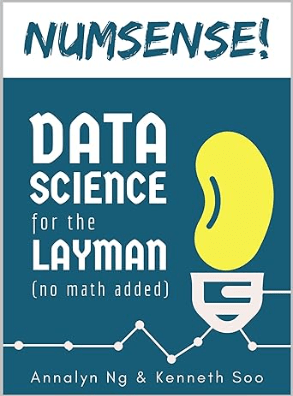
Numsense! Data Science for the Layman: No Math Added by Annalyn Ng and Kenneth Soo offers a refreshing take on data analytics books. Ng and Soo ingeniously simplify intricate data science concepts without overwhelming readers with technical jargon. Their book serves as a gateway, introducing fundamental data analysis techniques and predictive modeling principles in an accessible manner. Through practical examples and clear explanations, they empower readers to grasp data visualization tools and interpret statistical data with confidence. Numsense! is a must-read for anyone curious about harnessing the power of data without the burden of complex mathematics, making it a valuable resource in today’s data-driven landscape.
- Introduction to Data Science: Ng and Soo introduce readers to the fundamentals of data science without heavy mathematical equations.
- Data Visualization Techniques: The book covers essential data visualization methods to effectively communicate insights from data.
- Machine Learning Applications: Exploring practical applications of machine learning algorithms in everyday scenarios.
- Real-World Examples: Providing real-world examples that illustrate the relevance and impact of data science in different fields.
- Simplified Approach: Using a simplified approach to complex data analytics concepts, making it accessible for beginners.
3. Python for Everybody: Exploring Data in Python 3 by Dr. Charles Russell Severance
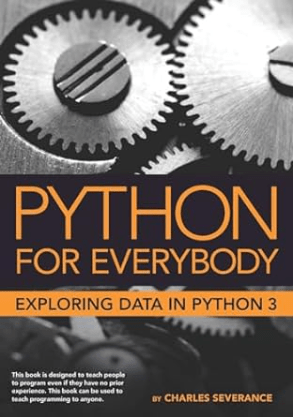
Python for Everybody: Exploring Data in Python 3 by Dr. Charles Russell Severance stands as a definitive guide among data analytics books. Dr. Severance adeptly demystifies Python’s power in data exploration and analysis. This book equips learners with essential programming skills tailored for data manipulation and visualization. By integrating practical exercises with real-world datasets, Severance cultivates a deep understanding of Python programming within the context of data science. Whether you’re a novice or seasoned professional, Python for Everybody is indispensable for mastering data handling techniques and fostering computational thinking in data analytics.
- Introduction to Python Programming: Dr. Charles Russell Severance provides a comprehensive introduction to Python programming, emphasizing its relevance in contemporary data analytics.
- Fundamentals of Data Analysis: The book delves into foundational data analysis techniques using Python, covering topics such as data manipulation, aggregation, and transformation.
- Advanced Data Visualization: Readers learn advanced data visualization methods and tools available in Python, enabling them to create insightful charts, graphs, and interactive plots.
- Database Integration: Severance explains database management principles, focusing on integrating Python with SQL databases for efficient data storage, querying, and management.
- Applied Data Science: Practical exercises and case studies reinforce learning, applying Python skills to data science tasks like predictive modeling, text analysis, and web scraping.
4. SQL QuickStart Guide: The Simplified Beginner’s Guide to Managing, Analyzing, and Manipulating Data With SQL by Walter Shields
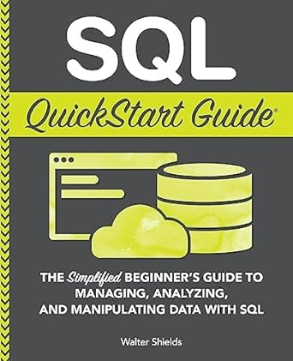
SQL QuickStart Guide: The Simplified Beginner’s Guide to Managing, Analyzing, and Manipulating Data With SQL by Walter Shields offers a comprehensive introduction to SQL for data analytics enthusiasts. Shields skillfully navigates readers through the intricacies of database management and query optimization. This book equips beginners with practical SQL skills essential for data manipulation and analysis. By focusing on real-world applications and hands-on exercises, Shields ensures a smooth learning curve, making SQL accessible for both novices and professionals in data-driven fields.
- Introduction to SQL Basics: Walter Shields provides a comprehensive introduction to SQL, emphasizing its role in data management and analysis within modern enterprises.
- Fundamental SQL Commands: The book covers essential SQL commands such as SELECT, INSERT, UPDATE, DELETE, and their practical applications in manipulating data.
- Database Design Principles: Shields explains crucial database design principles, including schema creation, normalization techniques, and indexing strategies to optimize data storage and retrieval.
- Advanced Query Techniques: Readers learn advanced data querying techniques such as subqueries, aggregations, and joins to extract complex insights from relational databases.
- Data Manipulation Strategies: Practical examples illustrate data manipulation strategies like sorting, filtering, and transforming data to meet analytical needs and business requirements.
5. Big Data: A Revolution That Will Transform How We Live, Work, and Think by Kenneth Cukier and Viktor Mayer-Schönberger
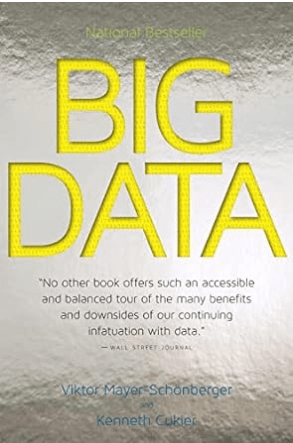
Big Data: A Revolution That Will Transform How We Live, Work, and Think by Kenneth Cukier and Viktor Mayer-Schönberger stands as a pivotal work in the realm of data analytics books. This insightful volume elucidates how the proliferation of data is reshaping industries, governance, and personal lives. Through astute analysis, the authors demonstrate the transformative power of big data, from predicting consumer behavior to revolutionizing healthcare. Their exploration into the ethical implications and potential pitfalls of data utilization provides a comprehensive understanding of its vast potential and inherent risks, marking it a cornerstone among data analytics books.
- Introduction to Big Data: Cukier and Mayer-Schönberger introduce the concept of big data as a paradigm shift in the collection, analysis, and utilization of vast datasets, emphasizing its impact on modern society and businesses.
- Data Analytics Insights: The book delves into advanced data analytics techniques, showcasing how organizations harness data to gain actionable insights and make informed decisions. Topics include machine learning algorithms, data mining, and statistical analysis.
- Applications Across Industries: Through detailed case studies, the authors illustrate big data applications across diverse sectors like healthcare (personalized medicine), finance (risk management), and retail (customer behavior analysis), highlighting specific benefits and challenges.
- Predictive Analytics: Exploring the role of predictive analytics in forecasting trends and behaviors based on historical data patterns, enabling proactive strategies in business and beyond.
- Ethical Considerations and Privacy: The book critically examines ethical implications surrounding data privacy, security breaches, and the responsible use of big data, prompting discussions on regulatory frameworks and societal implications.
6. Data Science for Business: What You Need to Know about Data Mining and Data-Analytic Thinking by Foster Provost and Tom Fawcett
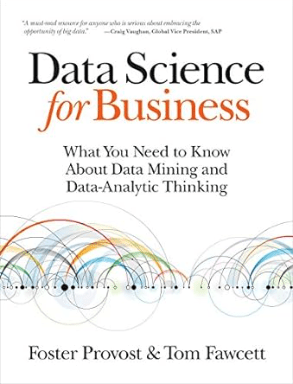
Data Science for Business: What You Need to Know about Data Mining and Data-Analytic Thinking by Foster Provost and Tom Fawcett is an indispensable resource in the realm of data analytics books. This authoritative guide provides a profound understanding of data mining techniques and their practical applications in the business world. Through comprehensive explanations and real-world examples, the authors illuminate the principles of data-analytic thinking, empowering readers to harness data-driven insights. The book’s emphasis on the symbiotic relationship between data science and business strategy makes it a vital reference for professionals seeking to excel in the burgeoning field of data analytics books.
- Introduction to Data Science for Business: Provost and Fawcett introduce data science as a transformative discipline for businesses, highlighting its role in leveraging data to gain competitive advantages and drive strategic decisions.
- Fundamentals of Data Mining: The book explores foundational concepts of data mining, including data preprocessing, pattern recognition, and predictive modeling techniques such as decision trees and neural networks. It emphasizes how these methods extract actionable insights from complex datasets.
- Data-Analytic Thinking: Provost and Fawcett advocate for data-analytic thinking, emphasizing critical thinking skills in interpreting data outputs, identifying correlations, and making informed business recommendations.
- Machine Learning Applications: Detailed examples illustrate the application of machine learning algorithms in business contexts, covering supervised and unsupervised learning techniques used for tasks like customer segmentation and fraud detection.
- Business Strategy and Analytics Integration: The authors discuss strategies for integrating data analytics into business operations, from optimizing marketing campaigns to improving supply chain management, showcasing real-world successes and challenges.
7. Artificial Intelligence: A Guide for Thinking Humans by Melanie Mitchell
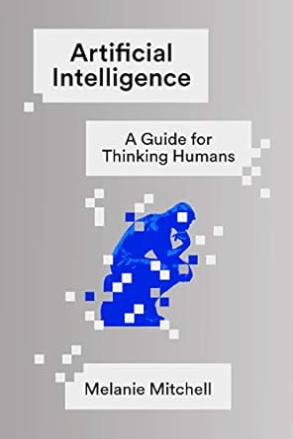
Artificial Intelligence: A Guide for Thinking Humans by Melanie Mitchell is a masterful exploration within the realm of data analytics books. Mitchell deftly unpacks the complexities of artificial intelligence, offering readers a nuanced understanding of its capabilities and limitations. With a blend of scientific rigor and accessible prose, she addresses the ethical dilemmas and societal implications of AI technologies. The book’s insightful narrative demystifies AI, making it an essential read for both novices and experts. Its profound insights place it among the most influential data analytics books, bridging the gap between technical depth and everyday relevance.
- Introduction to Artificial Intelligence: Melanie Mitchell introduces artificial intelligence (AI), emphasizing its role in revolutionizing technology and society. She discusses how AI mimics human intelligence through algorithms and data processing, making complex tasks feasible.
- Core Concepts Explained: Mitchell elucidates machine learning, detailing how AI systems learn from data to improve performance without explicit programming. She explores neural networks, the backbone of deep learning, and natural language processing, enabling machines to comprehend and generate human language.
- Applications and Limitations: Mitchell provides examples of AI applications across diverse fields such as healthcare, finance, and transportation. She examines the limitations of AI, including biases in data and the challenges of achieving true artificial general intelligence (AGI).
- Ethical Considerations: Addressing algorithmic bias and privacy concerns, Mitchell explores the ethical implications of AI technologies. She advocates for responsible AI development to mitigate risks and ensure equitable outcomes.
- Future Perspectives: Mitchell speculates on the future of AI, discussing potential advancements in autonomous systems, robotics, and AI’s impact on the job market and societal structures.
8. Storytelling with Data: A Data Visualization Guide for Business Professionals by Cole Nussbaumer Knaflic
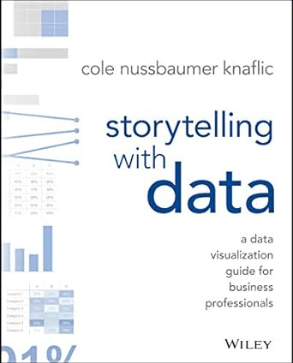
Storytelling with Data: A Data Visualization Guide for Business Professionals by Cole Nussbaumer Knaflic is an exemplary addition to the corpus of data analytics books. Knaflic expertly merges the art of storytelling with the science of data visualization, offering business professionals a robust framework for presenting data compellingly and clearly. Through a blend of practical examples and actionable insights, she demonstrates how to transform complex data sets into intuitive visual narratives. This guide not only enhances data literacy but also empowers professionals to communicate insights effectively, solidifying its place as a cornerstone among data analytics books.
- Introduction to Data Visualization: Knaflic’s book starts by emphasizing the pivotal role of data visualization in modern business communication. She highlights how visuals can transform complex data into clear, understandable insights that drive decision-making.
- Principles of Effective Visual Storytelling: Throughout the book, Knaflic lays out fundamental principles for creating compelling visual narratives. These principles emphasize the importance of clarity, simplicity, and impact in data presentations. She encourages readers to focus on the story behind the data, using visuals to enhance understanding rather than overwhelm with complexity.
- Design and Data Integration: Knaflic integrates design principles seamlessly with data analysis techniques. She demonstrates how thoughtful design choices can amplify the impact of data visuals, making information more accessible and engaging for diverse audiences.
- Techniques for Engaging Visuals: Practical techniques are explored in depth, including choosing the right chart types, color schemes, and layout designs to effectively convey insights. Knaflic emphasizes the need for visuals that are not only aesthetically pleasing but also purposeful in their communication.
- Storytelling Strategies: The book concludes with advanced strategies for data storytelling, such as incorporating narrative arcs, using annotations effectively, and leveraging storytelling frameworks to craft compelling narratives from data.
9. The Hundred-Page Machine Learning Book by Andriy Burkov

The Hundred-Page Machine Learning Book by Andriy Burkov is a quintessential guide in the arena of data analytics books. Burkov distills complex machine learning concepts into a concise and accessible format, making it an invaluable resource for both beginners and seasoned practitioners. The book covers fundamental algorithms, practical applications, and the theoretical underpinnings of machine learning. Its brevity and clarity make it a standout, providing readers with a comprehensive understanding without overwhelming them. This succinct yet profound work is a must-read, firmly establishing itself among the most impactful data analytics books available today.
- Introduction to Machine Learning: Burkov introduces the fundamental concepts of machine learning in a concise format, emphasizing practical applications over theoretical complexities.
- Core Concepts Covered: The book covers essential topics such as supervised learning, unsupervised learning, and deep learning, highlighting their relevance in modern data analytics and AI applications.
- Practical Approach: Burkov’s writing style focuses on practicality, offering step-by-step explanations and real-world examples to illustrate key concepts and algorithms.
- Mathematical Foundations: Despite its brevity, the book delves into mathematical foundations behind machine learning algorithms, ensuring a robust understanding of the underlying principles.
- Advanced Algorithms: Advanced machine learning techniques, including reinforcement learning and neural networks, are explored in a manner accessible to both beginners and seasoned professionals.
10. Business unIntelligence: Insight and Innovation beyond Analytics and Big Data by Dr. Barry Devlin
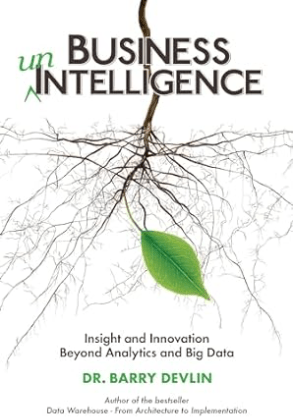
Business unIntelligence: Insight and Innovation beyond Analytics and Big Data by Dr. Barry Devlin is a groundbreaking contribution to the field of data analytics books. Devlin challenges conventional wisdom by proposing a holistic approach that transcends traditional analytics and big data paradigms. He delves into the integration of business intelligence, data warehousing, and analytics, advocating for a unified framework that fosters innovation and deeper insights. This book provides a visionary perspective, urging businesses to rethink their data strategies and embrace a more integrated and intelligent approach. It stands out as a must-read among data analytics books for its forward-thinking and comprehensive insights.
- Introduction to unIntelligence: Dr. Barry Devlin introduces the concept of unIntelligence, challenging conventional analytics by advocating for a holistic approach that integrates data architecture with business strategy.
- Critique of Traditional Approaches: The book critically examines the limitations of big data and standard analytics, emphasizing the need for a nuanced understanding of data integration and contextual relevance in business settings.
- Strategic Alignment of Data: Devlin underscores the significance of aligning data analytics initiatives with overarching business goals, proposing frameworks to bridge the gap between data insights and actionable strategies.
- Illustrative Case Studies: Through detailed case studies and real-world examples, Devlin illustrates how organizations can transform data assets into drivers of innovation and competitive advantage.
- Future Vision of Data Utilization: The book concludes with forward-looking insights into the future of data-driven decision-making, anticipating trends and challenges that will shape the landscape of business intelligence.
Data analytics books are the compasses that guide us through the vast seas of information.
Conclusion
In conclusion, exploring the diverse array of data analytics books opens doors to a deeper understanding of how data shapes our world. Each book, from foundational texts to cutting-edge insights, enriches our grasp of analytics, big data, and their transformative potential. These resources not only demystify complex concepts but also empower professionals to harness data as a strategic asset. Whether delving into machine learning, data visualization, or business intelligence, the knowledge gained equips us to innovate, strategize, and navigate the evolving landscapes of modern data-driven enterprises. Embracing these texts fosters a continuous journey of learning and adaptation in the dynamic realm of data analytics.
FAQ: Data Analytics Books
1. What are the best data analytics books for beginners? Several highly recommended data analytics books for beginners include:
- “Data Analytics Made Accessible” by Anil Maheshwari
- “Data Science for Business” by Foster Provost and Tom Fawcett
- “Python for Data Analysis” by Wes McKinney
- “The Art of Data Science” by Roger D. Peng and Elizabeth Matsui
2. What topics do data analytics books typically cover? Data analytics books typically cover topics such as:
- Introduction to data analytics
- Data collection and cleaning
- Data visualization techniques
- Statistical analysis
- Predictive modeling
- Machine learning algorithms
- Big data technologies
3. Are there any must-read data analytics books for advanced practitioners? Yes, advanced practitioners often recommend the following data analytics books:
- “Advanced Data Analytics Using Python” by Sayan Mukhopadhyay
- “Practical Statistics for Data Scientists” by Peter Bruce and Andrew Bruce
- “Data Science from Scratch” by Joel Grus
- “Pattern Recognition and Machine Learning” by Christopher M. Bishop
4. How can data analytics books help in career advancement? Data analytics books can help in career advancement by:
- Providing in-depth knowledge and skills in data analysis
- Offering practical examples and case studies for real-world applications
- Enhancing problem-solving and critical thinking abilities
- Keeping professionals updated with the latest trends and technologies in data analytics
5. Are there any free resources or data analytics books available online? Yes, some free resources and data analytics books available online include:
- “Introduction to Data Science” by Syracuse University (free PDF)
- “Data Science Handbook” by Field Cady (available online)
- “An Introduction to Statistical Learning” by Gareth James, Daniela Witten, Trevor Hastie, and Robert Tibshirani (free PDF)
6. What are the key features to look for in a good data analytics book? Key features to look for in a good data analytics book include:
- Clear and concise explanations of concepts
- Practical examples and case studies
- Step-by-step tutorials
- Comprehensive coverage of essential topics
- Accessibility for readers with different levels of expertise
7. Can data analytics books help prepare for certification exams? Yes, many data analytics books are specifically designed to help prepare for certification exams. Books such as:
- “Data Analytics for Beginners” by Paul Kinley
- “Certified Analytics Professional (CAP) Study Guide” by Eric Siegel
- “Big Data and Analytics Certification Handbook” by James L. Rowell can be useful for exam preparation.
8. Are there data analytics books focused on specific industries? Yes, there are data analytics books focused on specific industries such as:
- “Healthcare Analytics” by Jason Burke
- “Marketing Data Science” by Thomas W. Miller
- “Financial Analytics with R” by Mark J. Bennett and Dirk L. Hugen




служба поддержки мостбет номер телефона http://mostbet17.com.kg .
1вин сайт 1win38.com.kg .
1 вин вход в личный кабинет http://www.1win40.com.kg .
вход 1win вход 1win .
1win ракета 1win ракета .
1win kg скачать 1win34.com.kg .
1 вин 1 вин .
игра 1вин http://www.mostbet18.com.kg .
mostbet vxod mostbet3015.ru .
mostbet uz скачать http://mostbet3016.ru .
мостбет уз http://mostbet3020.ru/ .
1win kg http://www.1win36.com.kg .
mostbet uz com mostbet3019.ru .
1win. casino. http://1win2.com.mx/ .
игра ракета на деньги 1win игра ракета на деньги 1win .
1win онлайн [url=1win41.com.kg]1win41.com.kg[/url] .
мост бет http://mostbet19.com.kg/ .
1 win казино https://www.1win46.com.kg .
скачат мостбет http://mostbet20.com.kg .
win 1 https://1win101.com.kg/ .
1win ru https://mostbet21.com.kg/ .
1win вход https://www.1win100.com.kg .
1win букмекер https://1win102.com.kg .
1win live https://1win108.com.kg/ .
1win прямой эфир 1win42.com.kg .
игра ракета на деньги 1win игра ракета на деньги 1win .
1 vin svstrazh.forum24.ru/?1-18-0-00000135-000-0-0-1741169701 .
мостбет скачать http://www.cah.forum24.ru/?1-13-0-00001559-000-0-0 .
мосбет https://www.chesskomi.borda.ru/?1-10-0-00000277-000-0-0-1741171219 .
ванвин http://aqvakr.forum24.ru/?1-3-0-00001121-000-0-0/ .
1wiun http://www.cah.forum24.ru/?1-13-0-00001560-000-0-0-1741172791 .
1win сайт вход https://aktivnoe.forum24.ru/?1-8-0-00000254-000-0-0-1741273702 .
wan win http://1win109.com.kg/ .
1win официальный сайт регистрация http://1win10.am .
адин вин http://www.1win110.com.kg .
1vin https://1win103.com.kg .
1 win. https://1win111.com.kg .
1win бонус за приложение http://www.1win11.am .
1вин сайт http://www.1win13.am .
1 вин https://1win12.am/ .
1win. casino. 1win. casino. .
1win casino mexico 1win5.com.mx .
1win casino mexico https://1win4.com.mx/ .
1win site https://1win9.com.ng .
мостбет mostbet34.com.kg .
один вин https://1win104.com.kg .